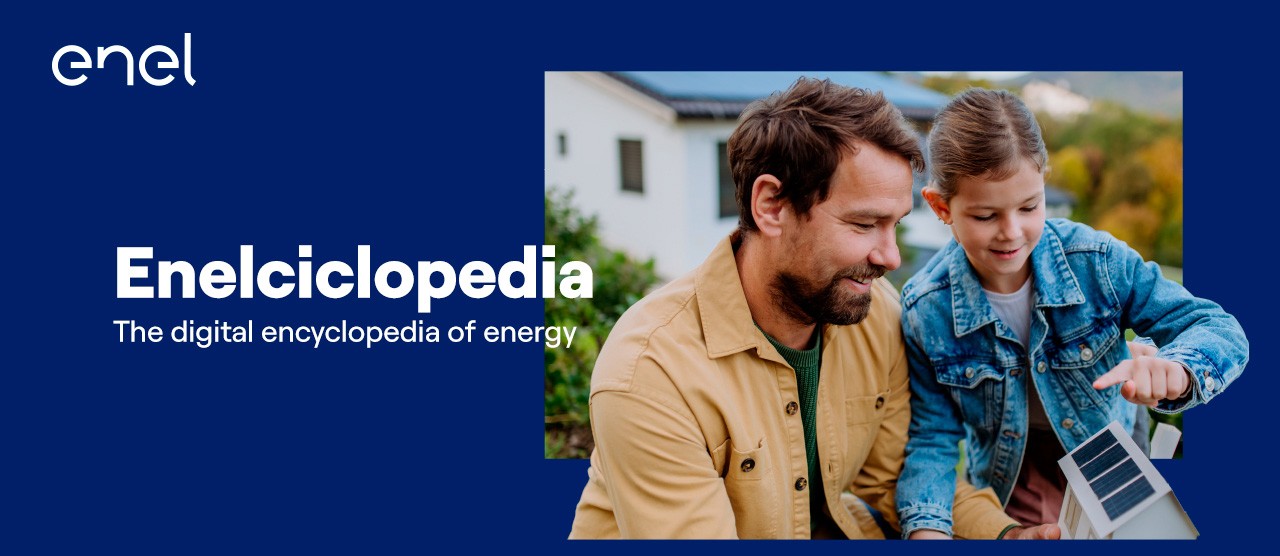B
BESS – Battery Energy Storage Systems
Electrochemical-type energy storage system. It applies to batteries based on lithium ions, NaS, Pb, NiMH, NiCd, ZBB, V-Redox, and others.
Bioenergy
Utilization of chemical energy stored in organic matter, such as biomass and biogas, through natural processes or technological converters.
Biomass
Set of materials of biological origin that can be used to generate electricity, be transformed into fuels and combustibles, or directly produce heat. They basically come from industrial and urban waste, energy crops, and biological products, waste, and residues from agriculture, forestry, or related industries. They are generally considered to be renewable sources because, unlike fossil fuels, the natural sources from which they are obtained are generated continuously.
Biomass Energy
Energy obtained from organic matter, such as agricultural and forestry residues, and organic waste, which is burned or converted into biogas to produce heat or electricity.
C
Carbon Capture and Storage (CCS)
Technology that captures carbon dioxide from industrial sources before it reaches the atmosphere and stores it in underground geological formations.
Circular Economy
Economic and sustainable development approach that seeks to reuse, recycle and regenerate natural resources and products at the end of their useful life, to minimize waste, material extraction and reduce environmental impact.
Clean Electrification
Use of renewable energy sources and low-carbon technologies to power energy systems, gradually replacing dependence on fossil fuels. This contributes to reducing greenhouse gas emissions and promoting a cleaner, more sustainable environment. Process of replacing polluting energy sources with electricity generated from renewable sources, with the purpose of reducing the environmental footprint.
CO2 Footprint
Average value of CO2 emitted into the atmosphere by plants when producing one unit of energy (1 kWh). The carbon footprint is the amount of carbon dioxide (CO2) emissions associated with the activities of a person or entity. It includes direct and indirect emissions, and may also consider other greenhouse gases.
Commercial Operation
Phase in which a technology, project, or service is in full operation and is actively being used to fulfill its intended economic purpose.
Concentrated Solar Power Plant
A facility that uses mirrors or lenses to concentrate solar light onto a focal point and generate electricity through a thermal system.
D
Decarbonization
Process of reducing or gradually eliminating dependence on fossil fuels and carbon emissions by transitioning to renewable energy sources and cleaner energy technologies. Reduction of carbon footprint by phasing out the use of fossil fuels and promoting low-carbon energy sources.
Distributed Generation
Production of energy in small facilities located near points of consumption, reducing losses in transmission and fostering energy resilience.
E
Electric Vehicles (EVs)
Automobiles powered by electric motors and rechargeable batteries instead of internal combustion engines.
Electrical System
The set of all infrastructure elements that make up the electricity production, transmission, distribution, and commercialization process. It comprises power generation plants, including storage, transmission and distribution grids, and all interconnected electrical infrastructures.
Electricity Generation
Activity to produce electricity through hydropower, solar, wind, and thermal sources.
Electrólisis
Chemical process that uses electrical energy to break a substance down into its constituent elements. Through electrolysis, green hydrogen can be produced by coupling an electrolyzer to a renewable power plant.
Electromobility
The use of electric vehicles (EVs) instead of conventional vehicles with internal combustion engines to reduce emissions of pollutants and decrease dependence on fossil fuels.
Emissions Baseline
Level of greenhouse gas emissions and particulate matter at a specific point in time, used as a reference to assess progress in emissions reduction.
Energy Balance
The balance of input and output energy flows in a power plant or geographical area, including the production, import, export, purchase, sale, transportation, transformation, and consumption of energy.
Energy Decentralization
Distribution of energy generation across multiple sources and locations, reducing dependence on large power plants.
Energy Distribution
Provision of electricity to homes, businesses, and other consumers through distribution networks.
Energy Efficiency
Optimized use of energy to perform a specific task, minimizing consumption and maximizing results.
Energy Grids
The infrastructure used to transport energy from the places where it is produced to the final consumer. In the case of electricity, the classical scheme involves two networks: the first is the transmission grid, which carries electricity at high voltage from the power generation plants to the primary substations. The second network is the distribution grid, which carries electricity at medium voltage to secondary substations and then, at low voltage, to the final consumers.
Energy Policy
Set of strategies and government objectives aimed at guiding the development and use of energy resources.
Energy Recycling
Reuse of energy generated as a byproduct of a process for additional purposes.
Energy Storage System
An energy storage system is a technological installation that allows for energy to be stored in intrinsic, potential, or kinetic form. The energy storage system allows for three processes: charging, storage, and discharging. They can be classified based on the physical form of stored energy, including mechanical, thermal, electromagnetic, chemical, or electrochemical.
Energy Storage Technology
Systems that store energy for later use, such as batteries, thermal storage systems, and hydroelectric storage in reservoirs.
Energy Transformation
Process of converting one form of energy to another, for example, the conversion of solar power into electricity.
Energy Transition
The switch from a system sustained by fossil fuels to one with low or zero carbon emissions. Our mission is to promote the use of renewable and sustainable energies. And given the vulnerability of our planet, we must act as quickly as possible.
Energy Transmission
The transportation of electricity through high-voltage lines from power generation plants to points of demand.
Environmental NGOs
Non-governmental organizations that work to promote environmental sustainability and the adoption of clean energy practices.
Environmental Sustainability
Commitment to reducing greenhouse gas emissions and adopting renewable energy sources to contribute to the fight against climate change.
F
Fuel Switching
Substitution of coal capacity with other less polluting and more sustainable energy sources, such as gas.
G
Generator
Device that generates electrical energy from different forms of energy: mechanical, chemical, luminous, or thermal. The different types of generators include the dynamo, to produce direct current, and the alternator, to generate alternating current.
Geothermal Energy
Energy from the Earth's internal heat, harnessed to generate electricity or provide heating by capturing heat from the subsurface.
Geothermal Power Plant
A geothermal power plant is a facility that allows for heat from natural fluids from Earth's reservoirs to be converted into electricity. It works by capturing steam and/or underground hot water, which drives a turbine connected to a generator through a thermal exchange system, thus producing renewable energy.
Green Hydrogen
Hydrogen produced from renewable energies, such as the electrolysis of water using electricity generated by clean sources.
Greenhouse Gases
Greenhouse gases are substances present in the atmosphere that trap infrared radiation, contributing to global warming. Carbon dioxide, methane and water vapor are the main ones. Although they are a small fraction of atmospheric gases, they have a major impact on the planet's energy balance. Throughout history, the concentrations of these gases have fluctuated, causing significant climatic changes.
GW / GigaWatt
A gigawatt (GW) is a unit of power that indicates the capacity for large-scale electrical generation, equivalent to 1 billion watts.
H
Hybrid Power Plant
An innovative energy solution that combines clean technologies such as solar, wind, and energy storage into a single system. This integration allows us to maximize renewable generation, ensure a stable power supply in any situation, and provide complementary services to the grid.
Hydropower
Energy generated from the flow of water in rivers or reservoirs, captured by turbines that convert the kinetic energy of water into electricity.
Hydropower Plant
Hydropower plants use the potential and kinetic energy of water to generate clean electricity. Taking advantage of the force of rivers or reservoirs to spin turbines, which, in turn, activate electric generators.
I
Intergovernmental Panel on Climate Change (IPCC)
International organization founded in 1988 by the World Meteorological Organization (WMO) and the United Nations Environment Program (UNEP) for the main purpose of assessing, based on scientific foundations and real evidence, the potential impact of human activity on climate change.
M
Microgrid
Energy distribution system that combines local generation, storage, and smart charging to operate independently or in conjunction with the main grid, under optimal management of its various components.
Monofacial Tracking Structures
Support structures (also called “trackers”) for solar panels that move to keep the panels perpendicular to the sunlight at all times.
N
Net Zero
Scenario in which the greenhouse gas emissions produced are equivalent to those removed from the atmosphere, achieving a balance in terms of emissions.
Non-Conventional Energy Sources
Energy sources other than traditional fossil fuels, including solar, wind, geothermal, biomass, and tidal.
P
Peak Demand
The moment in the day in which electricity demand is at its highest, which may require the activation of additional generation plants.
Photovoltaic Solar Power
It is the direct transformation of solar radiation into electricity and occurs in devices known as photovoltaic modules. Photovoltaic solar cells, which make up a photovoltaic module, directly convert sunlight into electricity through the so-called photovoltaic effect. One of its main virtues is its modular nature, as it can be used to build anything from large ground-based photovoltaic plants to small panels for roofs and rooftops.
Pumping Station
Type of hydropower station formed by a water collector press. It is an energy storage system with the physical form of “Mechanical energy” (potential energy). The water that generates electricity during the day is stored in the reservoir located at the lowest level and can be pumped back to the reservoir at the highest elevation during periods of lower electrical demand and/or lower energy prices (for example, during the day and/or early morning). In this way, the water pumped to the upper reservoir, consuming energy, can be reused to generate electricity during peak demand hours (higher energy prices), allowing for arbitrage and providing complementary services to the grid that are useful for its stabilization and security.
R
Radiation / Solar Energy
Solar energy is an environmentally friendly energy alternative that is easy to store and can generate electricity in remote locations. Solar energy is found in two forms: in natural light and heat. Solar energy is obtained through photovoltaic modules, which capture solar radiation and transform it into electrical energy.
Renewable Energy
Renewable energy represents the core of the energy transition. Thanks to its clean and inexhaustible energy, it can drastically reducing emission levels. These energies are essential for the sustainable future of the planet.
Renewable Energy Companies
Organizations dedicated to the generation, distribution, and commercialization of energy from renewable sources such as solar, wind, hydropower, etc.
Renewable Energy Sources
Energy sources other than traditional fossil fuels, including solar, wind, geothermal, biomass, and tidal.
S
Smart Charging
System that automatically adjusts the charging of electric vehicles to avoid demand spikes and optimize the use of the electrical grid.
Smart Cities
Urban environments that use information and communication technologies (ICTs) to improve operational efficiency, residents' quality of life, and resource management.
Smart Grid
An electrical distribution system that utilizes information and communication technologies to optimize energy generation, transmission, and consumption.
Solar Photovoltaic (PV) Panel
Device composed of a set of photovoltaic modules, which are in turn made up of photovoltaic cells. The cells allow for the direct conversion of solar radiation into electricity, harnessing the photoelectric effect, and are the basic element of the photovoltaic plant. The most widespread version of the cell is made with crystalline material and is formed by a layer of semiconductor material.
Solar Power
Energy generated from solar radiation, captured through solar panels and converted into electricity or heat.
Sustainability
Ability to conserve and protect the planet's natural resources and ecological balance over the long term. It involves minimizing the environmental footprint, promoting biodiversity conservation, reducing pollution and promoting the efficient use of resources, all with the aim of ensuring the preservation of ecosystems for future generations.
Sustainable Development Goals (SDGs)
The SDGs are universal goals established by the United Nations to address global challenges such as poverty, hunger, inequality and climate change. They are 17 goals and 169 indicators that seek sustainable development in all aspects by 2030.
Sustainable Development
Social, economic and environmental planning approach that seeks to meet present needs without compromising the ability of future generations to meet their own needs.
Sustainably Mobility
Exploration of initiatives and projects related to the electrification of transportation to reduce dependence on fossil fuels.
T
Technological Innovation
The development and application of new technologies that can enhance the efficiency, reliability, and sustainability of energy systems.
TWh
A Terawatt-hour (TWh) is a unit of energy that represents the amount of electricity consumed or generated on a large scale. It is equivalent to one trillion watt-hours.
V
Variable Generation
Energy production from sources such as solar and wind that varies based on climate conditions and the availability of the primary natural resource.
W
W (Watt)
The Watt (W) is a unit of measurement for power, indicating the rate at which electrical energy is consumed or generated at a specific instant.
Wave Power
Energy generate by the movement of the waves and ocean currents.
Wh (Watt-hour)
The Watt-hour is a unit of energy that represents the amount of electricity consumed or generated over a period of one hour.
Wind Power
Energy obtained from the wind through wind turbines, which convert the kinetic energy of the wind into electricity.
Wind Power Plant
A wind power plant is a facility that captures the kinetic energy of the wind through the blades of wind turbines, converting it into mechanical energy and then transforming it into electricity through the movement of its blades. They are a clean and renewable energy source that helps reduce emissions and promote sustainability.
Wind Turbine
Electromechanical device that can convert the kinetic energy of the wind (wind power) into electricity.


